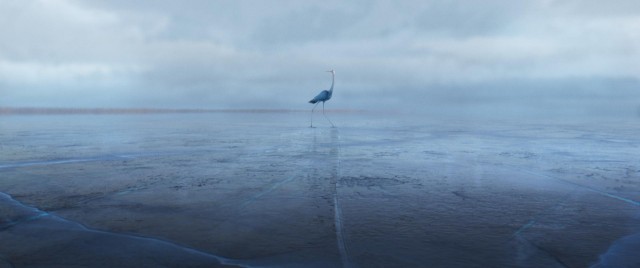The winner of a student BAFTA and a festival favourite from 2020, animated short Sous la Glace (Under the Ice) arrives online with quite a grand reputation. A slick 3D animation that follows a heron’s desperate attempts to feed under harsh winter conditions, this seven-minute short makes up for its slight storyline (it feels like a scene from a David Attenborough documentary) with some truly impressive craft.
Created by six students as part of their studies at École des Nouvelles Images (the French school which also gave us Wild Love and Hors Piste), the short balances a meditative nature with moments of humour as it immerses us in its tale of bird v fish v nature. Interviewed for the Mill website, where she works as a Junior 3D animator, co-director Laurie Estampes reveals how the team aimed to highlight “how winter could be so poetic and beautiful, but also very dangerous and chaotic at the same time”, when creating Sous la Glace.

Though the film centres on a heron and the fish it’s trying to catch, the environment feels like a third character in the short.
Initially beginning as a story centred around a forest and how it’s impacted by a devastating winter, the original narrative aimed to capture how a multitude of animals adapted to these conditions. As time went by and the project developed, the team decided it made more sense to focus on just one character, the heron – who had been one of the main animals they followed in their original premise.
In all honesty though, this isn’t a standout short for its storytelling, where it really succeeds is in that glorious production. Whenever watching films set in the winter, I always think that if it’s going to engage you in its world, you need to feel that biting snap of winter in your bones and Sous la Glace excels in this department. From the way the heron clumsily skates across the ice to how its feathers dance in the neverending wind, the character design perfectly compliments the film’s hazy winter landscapes. The sound design completes the picture, the constant rumbling of wind underscoring the entire short, getting louder as winter sets in and quieter as the heron finds refuge on an old abandoned boat – not bad considering the student team created all their foley sounds themselves, as Estampes explains:
“When all of the animation was done, Flore, Milan and myself were tasked with creating audio for the movie. For this, we did things like buying chicken and fish, and recording audio while flapping them around on some ice to make the sound of fish on ice for the film. Making noises for the heron character was quite tricky, because you can’t find any good heron sounds on the internet, so we had to make our own. We made it by mixing the sounds of cats and ducks, as well as seals”.
As if often the way with students films, it sounds as if compromises were made along the production journey, with Estampes revealing (again in that Mill interview) that they “had to tweak a lot of things to make the movie work, and make sure everybody in the team was happy”. I’m sure that was a vital lesson for all of the co-directors to learn and something they’ve been able to carry into their working lives. More importantly though, the decision making here certainly paid off, as Sous la Glace is a striking film that should serve as a steady foundation for the rest of their career.

 Rob Munday
Rob Munday